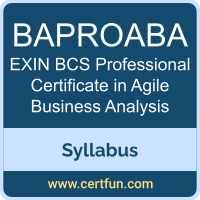 Use this quick start guide to collect all the information about EXIN BAPROABA Certification exam. This study guide provides a list of objectives and resources that will help you prepare for items on the EXIN BCS Professional Certificate in Agile Business Analysis (BAPROABA) exam. The Sample Questions will help you identify the type and difficulty level of the questions and the Practice Exams will make you familiar with the format and environment of an exam. You should refer this guide carefully before attempting your actual EXIN BCS Professional Certificate in Agile Business Analysis certification exam.
Use this quick start guide to collect all the information about EXIN BAPROABA Certification exam. This study guide provides a list of objectives and resources that will help you prepare for items on the EXIN BCS Professional Certificate in Agile Business Analysis (BAPROABA) exam. The Sample Questions will help you identify the type and difficulty level of the questions and the Practice Exams will make you familiar with the format and environment of an exam. You should refer this guide carefully before attempting your actual EXIN BCS Professional Certificate in Agile Business Analysis certification exam.
The EXIN BAPROABA certification is mainly targeted to those candidates who want to build their career in Business & Service Management domain. The EXIN BCS Professional Certificate in Agile Business Analysis exam verifies that the candidate possesses the fundamental knowledge and proven skills in the area of EXIN BAPROABA.
EXIN BAPROABA Exam Summary:
| Exam Name | EXIN BCS Professional Certificate in Agile Business Analysis |
| Exam Code | BAPROABA |
| Exam Price | $646 (USD) |
| Duration | 90 mins |
| Number of Questions | 40 |
| Passing Score | 65% |
| Books / Training | View the Business Analysis certification program |
| Schedule Exam | EXIN |
| Sample Questions | EXIN BAPROABA Sample Questions |
| Practice Exam | EXIN BAPROABA Certification Practice Exam |
EXIN BAPROABA Exam Syllabus Topics:
| Topic | Details | Weights |
|---|---|---|
| Agile philosophy |
1. The business analysis service framework 2. Business agility
3. The Agile business analyst
4. Growth and fixed mindset
|
5% |
| Agile principles |
1. The three elements of agile delivery
2. The Agile Manifesto
|
10% |
| Agile Methods |
1. Key elements in Agile methods 2. Agile methods
|
10% |
| Working with stakeholders and roles |
1. Stakeholder engagement
2. Stakeholder categories, roles and perspectives
|
10% |
| Modeling the business context |
1. Business analysis and the business context 2. The Cynefin framework 3. The functional model map (FMM)
4. Modeling the business system
|
10% |
| Goal decomposing and prioritization |
1. Goal and functional decomposition 2. Cockburn’s levels of goals 3. The importance of prioritization 4. Prioritization techniques
5. Prioritization decomposition |
10% |
| Deciding the requirements approach |
1. The requirements engineering framework: requirements slices 2. The Product Owner role 3. Techniques for elaborating requirements iteratively 4. Prototyping
5. Definition of ready and definition of done |
10% |
| Modeling roles, stories and scenarios |
1. User research and analysis 2. User roles
3. Modeling the system context and scope
4. User stories
5. Techniques
|
15% |
| Organizing and estimating requirements |
1. Types of requirements: technical, general, functional, non-functional 2. The itemized backlogs
3. Ordering the backlog
|
10% |
| Planning and managing iterations |
1. The iteration 2. Iterations and goals 3. Planning the iteration
4. Techniques to manage the iteration:
|
10% |
To ensure success in EXIN BAPROABA certification exam, we recommend authorized training course, practice test and hands-on experience to prepare for EXIN BCS Professional Certificate in Agile Business Analysis (BAPROABA) exam.
